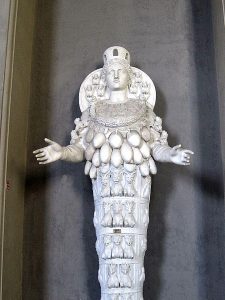When one reads standard reference works about the New (Christian) Testament and the early Jesus movement one would almost never know that there is a woman mentioned in the letter to the Colossians.  It has taken recent research by female scholars to uncover yet another woman who served the movement in the same ways that men did. (We have explored other “hidden” or somewhat neglected women leaders earlier, especially those associated with St. Paul: the women of Romans 16, Junia, Chloe, Persis, and Euodia and Syntyche). Here we will explore not only the probability that a significant woman of an early Jesus group is mentioned in Colossians but also the history of scholarship – and the history of the established church – that effectively kept this woman hidden from our view for millennia.
It has taken recent research by female scholars to uncover yet another woman who served the movement in the same ways that men did. (We have explored other “hidden” or somewhat neglected women leaders earlier, especially those associated with St. Paul: the women of Romans 16, Junia, Chloe, Persis, and Euodia and Syntyche). Here we will explore not only the probability that a significant woman of an early Jesus group is mentioned in Colossians but also the history of scholarship – and the history of the established church – that effectively kept this woman hidden from our view for millennia.
The Problem/s
Colossians 4:15 reads (NRSV): “Give my greetings to the brothers and sisters in Laodicea, and to Nympha and the church in her house.” In the beloved 1611 King James Version, however, the verse reads, “Salute the brethren which are in Laodicea, and Nymphas, and the church which is in his house.” Other versions translate the verse in roughly one of these two ways.
This short verse raises a host of issues. ![]() First, church tradition for millennia has attributed this letter to Paul and fixes the date of the writing to 50-60 of the Common Era (CE) (O’Brien, 563; Unger, 214; Johnston, 658; among others). Many commentators note the similarities between Colossians and Ephesians (also traditionally attributed to Paul). As we have noted earlier, however, among the similarities is the so-called Household Codes. These verses – which lay out regulations for women, children and slaves – not only do not appear in the authentic letters of Paul but also contradict his basic theology. Ephesians is better dated from manuscript and other evidence to 80-100 CE, after Paul’s death around 64 CE. Therefore, while Colossians may have been written earlier than Ephesians, it almost certainly was not written but Paul.
First, church tradition for millennia has attributed this letter to Paul and fixes the date of the writing to 50-60 of the Common Era (CE) (O’Brien, 563; Unger, 214; Johnston, 658; among others). Many commentators note the similarities between Colossians and Ephesians (also traditionally attributed to Paul). As we have noted earlier, however, among the similarities is the so-called Household Codes. These verses – which lay out regulations for women, children and slaves – not only do not appear in the authentic letters of Paul but also contradict his basic theology. Ephesians is better dated from manuscript and other evidence to 80-100 CE, after Paul’s death around 64 CE. Therefore, while Colossians may have been written earlier than Ephesians, it almost certainly was not written but Paul.
This means that, while these letters may include valuable advice to the early Jesus groups, they should not be viewed as authoritative by Paul. Unfortunately, the various commentators who have attributed such letters to Paul mislead not only casual readers of these texts but also teachers, pastors, church leaders, professors and others with great authority over multitudes. This level of authority in turn impacts how the experts and leaders view someone like the person named in Col 4:15 – and perhaps also the other people mentioned by name in this letter.
- Cruden in Cruden’s Complete Concordance lists the figure as Nymphas. Someone using this resource who does not know Greek could well assume that this figure is male. Someone who does know Greek would recognize that the ending “as” does signify the male gender. This interpretation derives from a translation of the ending of the name in Greek as male in a number of ancient manuscripts.
- An early work since the advent of feminist Biblical scholarship, Gryson’s The Ministry of Women in the Early Church (4 and 127), took some important steps in elucidating the roles of women. Gryson was nuanced in his treatment of Nympha. In a note related to Phoebe and early house churches, Gryson states, “At this time, Christian communities certainly met in private houses…. There is also mention of a community meeting in the house of Prisca and Aquila… in that of Philemon, … and in that of Nympha at Laodicea… In this last reference, the Nestle edition [that is, the Nestle–Aland edition of the New Testament in Greek] preferred the reading of Nympha as a woman …, though most manuscripts read the masculine.”
- There is only a short treatment of Colossians in Unger’s Bible Dictionary (214). Unger does attribute it to Paul. At the end, under “Part IV, Personal Matters, 4:7-17,” he mentions the men Tychicus and Onesimus, but about 4:15, under the heading “Paul’s own greetings,” there is no mention of Nympha/Nymphas. However, Unger does have a separate listing (800): “Nymphas, a prominent Christian in Laodicea, whose house was used as a place of worship.”
 Again, the use of the “as” ending with no other explanation leads readers to assume that the reference is to a man.
Again, the use of the “as” ending with no other explanation leads readers to assume that the reference is to a man. - The influential Interpreter’s Dictionary of the Bible: An Illustrated Encyclopedia, used by many candidates for the priesthood across several denominations, also asserts that Colossians was written by Paul (Johnston, 658-59), although this treatment is more detailed than many others. In a short discussion of house churches (661), Johnston says parenthetically about 4:15, “the text here is uncertain; Nympha or Nymphas is equally possible; cf. Philem. 2; Acts 16:15.” This at least leaves the door open to this person being a woman.
- In the entry on Nympha in The Interpreter’s Dictionary of the Bible (574), author Gingrich notes in some detail the uncertainty about the figure’s gender in the early manuscripts, the KJV, etc., concluding, “It is impossible to decide which is right, though the feminine form has the disadvantage of being Doric for the more usual Attic Νύμφη.” Again, the basic take-away for readers is that the figure is male.
- Another influential resource used by many researchers in early church history and related fields is The Oxford Dictionary of the Christian Church. Its short entry on Colossians unapologetically attributes authorship to Paul (316); the only person mentioned in the entry besides Paul is Epaphras.
- The Oxford Companion to the Bible, similarly, attributes Colossians to Paul (O’Brien, 128). The article mentions Epaphras but glosses over all the other members of the Jesus mission under the heading “Personal greetings and instructions,” with no further comment.
Furthermore, as if these misleading interpretations and analyses were not bad enough, there is also the problem of silence.
- Pfeiffer and Harrison in The Wycliffe Bible Commentary state about Col 4:15, in a paragraph called “The Apostle’s Greetings and Blessings,” “The ‘house-church’ was widespread, both in the Pauline congregations and in general.” In contrast, in reference to “the Bearers of the Letter” and Paul’s Co-Workers,” the men Epaphras, Mark, Aristarchus, Demas, Tychicus, Onesimus and Archipus are all mentioned in this article. There is no mention of Nympha – thus irresponsibly avoiding the gender issue altogether.

- Unbelievably, The Oxford Dictionary of the Christian Church, such an influential and respected reference work, does not have an entry on Nympha.
- Sadly, the same can be said of Oxford Companion to the Bible, which was published well into the era of feminist scholarship.
One of the most effective ways, over time, to reduce the power and influence of women – in church and society – is to ignore and silence them. And one way to silence a woman whose name is found in the texts is to masculinize her name. This is what has happened to Nympha, as it did to Junia (MacDonald, “Rereading,” 251).
Nympha as Female: The Evidence
Despite what we have witnessed from the above selection of (male) translators and commentators, even as they have relied on manuscript evidence and statements by the church fathers, ample evidence for considering Nympha to be a woman has become available over the past couple of decades – and should no longer be ignored.
First, the male name “is not found among Roman inscriptions from this period, whereas the feminine Nympha is attested more than sixty times (mostly for slaves and freedwomen)” (Kraemer, “Nympha,” 132-33). This is another parallel with Junia’s situation.
The woman named in Col 4:15 seems to have owned her home, as did other women in the Imperial era. Several scholars read the passage as indicating that Nympha was one of these and hosted a house church for Jesus group members. Others like her from the Christian Testament may have included Prisca (along with her husband Aquila) and Chloe (D’Angelo, “Reconstructing,” 108; MacDonald, “Reading,” 200). For many men involved with the church over time, however, it was inconceivable that a woman without a man could own her home and thus host a house-church.
Nympha is not identified with any man in the passage, a further indication of her independence and the probability that she had control of her own funds – but outside the imagination of the translators and commentators who considered that the text had to refer to a man. Even if Nympha was a figure created by the author of Colossians, which is possible, it demonstrates that the author knew of such independent women in the early Jesus movement (Kraemer, “Nympha,” 132-33).
We also observe that a standard Greek-English lexicon lists the name Nympha (feminine) with no comparable male name. Under Nympha, some of the definitions include “a young wife,” “any married woman,” and “a marriageable maiden.” As a proper name, it is a “goddess of lower rank.”  The plural form is associated with things in the natural world (Lexicon, 468). As we have noted in the past, (Christian practices; Roman catacombs) it was primarily the ancient goddess who was not only associated with nature but also identified with it, and the ancient goddess survived into the Imperial era (and beyond) in the forms of other female deities such as Artemis, Aphrodite, the Great Mother, and so on. There is very little justification for the name Nympha to be associated with men in this context.
The plural form is associated with things in the natural world (Lexicon, 468). As we have noted in the past, (Christian practices; Roman catacombs) it was primarily the ancient goddess who was not only associated with nature but also identified with it, and the ancient goddess survived into the Imperial era (and beyond) in the forms of other female deities such as Artemis, Aphrodite, the Great Mother, and so on. There is very little justification for the name Nympha to be associated with men in this context.
A final word can be said about the manuscripts from which our texts have come. The issue is complex, but manuscripts were copied by nuns and monks in ancient convents and monasteries, and the copying was not always perfect. There were also many occasions in which, for whatever reason, changes in the texts were deliberately made. What we are seeing, therefore, is the masculinizing of the name Nympha in the manuscript tradition and in the resources which depend on them. As MacDonald states, “the attempt to masculinize Nympha … is rooted in the scandal created by the existence of a woman leader of a house-church” (MacDonald, “Reading,” 209). MacDonald further notes, “[Nympha’s] memory has been preserved despite attempts to masculinize her in the manuscript tradition” (MacDonald, “Rereading,” 244).
Implications
If this house church leader in Col 4:15 is actually a woman named Nympha and not a man with the (concocted) name Nymphas, we can make several observations about the Jesus group at the ancient city of Laodicea and about how we can evaluate our resources about the Christian Testament:
- The evidence is compelling, if not overwhelming, that the person mentioned in Col 4:15 is a woman, Nympha.
- This woman may have owned her home, since the text states that she hosted an assembly of Jesus group members there. Thus we can safely say that there were female Jesus followers and leaders in Laodicea.
- The translations of this verse that created the unattested name Nymphas as masculine is not true to the original Greek and is misleading to those who read, study and wish to learn from the text.
- The author of Colossians was almost certainly not St. Paul but rather someone who wrote and circulated the letter somewhat after Paul’s time. The author did seem to know of the tradition of women owning their own homes and/or hosting members of the Jesus groups.
- The commentaries that emphasize the men mentioned in Colossians to the exclusion and/or masculinizing of Nympha paint a misleading picture that has served to oppress women for millennia. Teachers, pastors, priests and professors who use these commentaries should make careful note of these errors to their respective “flocks.”
Nympha can and should now be added to the list of all the women in the Christian Testament texts – both Pauline and non-Pauline – who have shaped the earliest Jesus movement and, indeed, the whole history of Christianity. These women can serve as role models not only for those of us in the Christian tradition but in the West as well. There is no longer any rationale for excluding women from leadership positions or granting women second-class citizenship in church or society.
Resources
“Colossians, Letter to the,” in F.L. Cross and E.A. Livingstone, eds., The Oxford Dictionary of the Christian Church, 316. Oxford: Oxford Univ. Press, 1985.
Cross, F.L. and E.A. Livingstone, eds. The Oxford Dictionary of the Christian Church. Oxford: Oxford Univ. Press, 1985.
Cruden, Alexander. Cruden’s Complete Concordance, ed. A.D. Adams, C.H. Irwin, and S.A. Waters, 464. Grand Rapids: Zondervan Publishing House, 1972; originally published 1930.
D’Angelo, Mary Rose. “Reconstructing ‘Real’ Women from Gospel Literature: The Case of Mary Magdalene,” in Ross Shepard Kraemer and Mary Rose D’Angelo, eds. Women and Christian Origins, 105-28. New York and Oxford: Oxford University Press, 1999.
Gingrich, Felix Wilbur. “Nympha,” in George Arthur Buttrick, ed. The Interpreter’s Dictionary of the Bible: An Illustrated Encyclopedia, Vol. K-Q, 574. Nashville and New York: Abingdon Press, 1962.
Gryson, Roger. The Ministry of Women in the Early Church. Collegeville, MN: The Liturgical Press, 1976.
Johnston, G. “Colossians, Letter to the,” Interpreter’s Dictionary of the Bible, Vol. A-D, 658-62. Nashville: Abingdon, 1962.
Kraemer, Ross S. “Nympha,” in Carol Meyers, Toni Craven and Ross S. Kraemer, eds., Women in Scripture: A Dictionary of Named and Unnamed Women in the Hebrew Bible, the Apocryphal/Deuterocanonical Books, and the New Testament, 132-33. Grand Rapids, MI, and Cambridge, England: William B. Eerdmans Publishing Company, 2000.
Lexicon, A: Abridged from Liddell and Scott’s Greek-English Lexicon. Oxford: Clarendon Press, 1974.
MacDonald, Margaret Y. “Reading Real Women Through the Undisputed Letters of Paul,” in Ross Shepard Kraemer and Mary Rose D’Angelo, eds., Women and Christian Origins, 199-220. New York and Oxford: Oxford University Press, 1999.
MacDonald, Margaret Y. “Rereading Paul: Early Interpreters of Paul on Women and Gender,” in Ross Shepard Kraemer and Mary Rose D’Angelo, eds., Women and Christian Origins, 236-53. New York and Oxford: Oxford University Press, 1999.
Metzger, Bruce M. and Michael D. Coogan, eds. Oxford Companion to the Bible. New York and Oxford: Oxford University Press, 1993.
O’Brien, Peter T. “Colossians, The Letter of Paul to the,” in Bruce M. Metzger, and Michael D. Coogan, eds. Oxford Companion to the Bible, 127-29. New York and Oxford: Oxford University Press, 1993.
Pfeiffer, Charles F. and Everett F. Harrison. The Wycliffe Bible Commentary, 1345-46. Chicago: The Moody Bible Institute, 1962.
Unger, Merrill F. Unger’s Bible Dictionary. Chicago: Moody Press, 1971.
